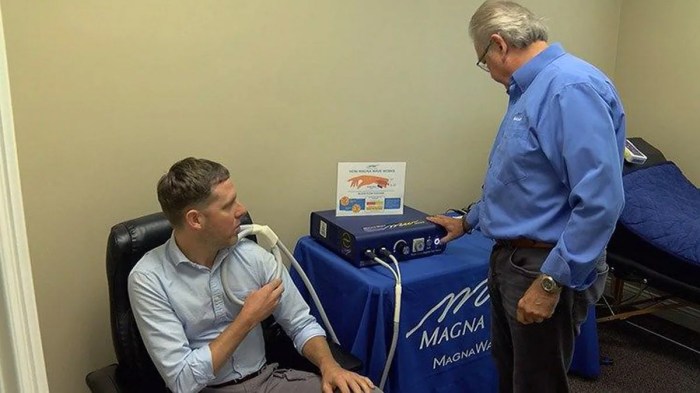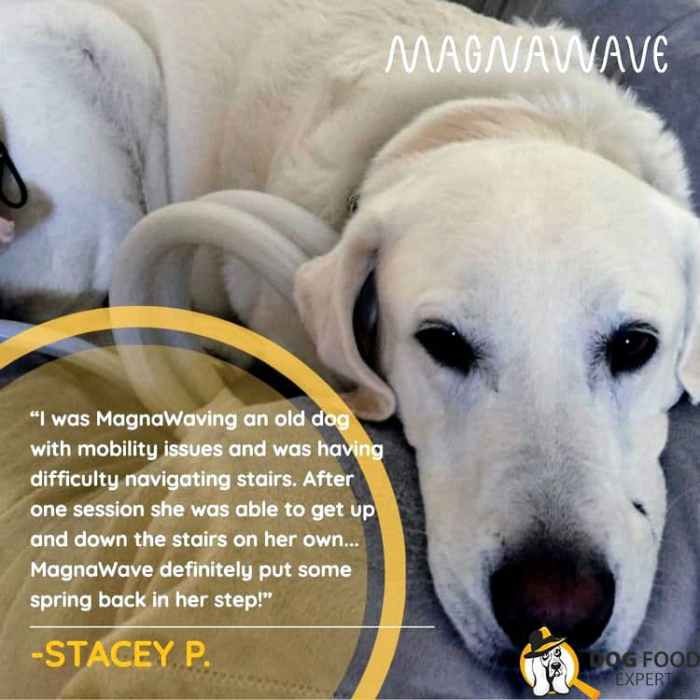Magna Wave Therapy for dogs is revolutionizing the way we approach canine health and wellness. This non-invasive therapy harnesses the power of pulsed electromagnetic fields (PEMFs) to promote healing, reduce pain, and enhance athletic performance.
With its ability to penetrate deep into tissues, Magna Wave Therapy stimulates cellular regeneration, reduces inflammation, and improves blood circulation. This translates into a wide range of benefits for dogs, from pain relief to improved mobility and reduced recovery time after injuries.
Magna Wave Therapy

Magna Wave Therapy is a non-invasive therapeutic modality that utilizes pulsed electromagnetic fields (PEMFs) to stimulate cellular activity and promote healing in the body. It is based on the principle that living cells generate and are influenced by electromagnetic fields, and that disruptions in these fields can lead to various health issues.
Magna Wave Therapy employs specific frequencies and waveforms to target different physiological processes. These PEMFs penetrate deeply into tissues, interacting with cell membranes and influencing cellular functions such as ion transport, protein synthesis, and gene expression.
Targeted Physiological Effects
Magna Wave Therapy has been shown to exert a range of targeted physiological effects, including:
- Enhanced blood flow and oxygenation
- Reduced inflammation and pain
- Improved tissue repair and regeneration
- Increased cellular energy production
- Modulation of the immune system
- Reduced oxidative stress
These effects contribute to the overall therapeutic benefits of Magna Wave Therapy, making it a versatile treatment option for a wide range of conditions in dogs.
Applications of Magna Wave Therapy for Dogs

Magna Wave Therapy is a non-invasive, pulsed electromagnetic field (PEMF) therapy that has gained popularity in veterinary medicine due to its effectiveness in treating a wide range of conditions in dogs. This therapy utilizes specific frequencies and intensities of electromagnetic waves to stimulate cellular repair and reduce inflammation.
Musculoskeletal Conditions
Magna Wave Therapy is particularly beneficial for addressing common musculoskeletal conditions in dogs, including:
- Arthritis
- Hip dysplasia
- Elbow dysplasia
- Osteoarthritis
- Tendon and ligament injuries
Pain Management
Magna Wave Therapy effectively reduces pain in dogs by targeting the source of inflammation and stimulating the release of endorphins, the body’s natural pain relievers. This therapy can provide significant pain relief for dogs suffering from chronic pain conditions, such as arthritis, hip dysplasia, and other musculoskeletal issues.
Athletic Performance and Recovery, Magna wave therapy for dogs
Magna Wave Therapy has also shown promise in enhancing athletic performance and recovery in dogs. By improving blood flow and oxygenation to muscles, this therapy can help dogs perform better and recover faster after exercise. Additionally, it can reduce muscle soreness and stiffness, promoting overall well-being and performance.
Treatment Protocol and Considerations: Magna Wave Therapy For Dogs

Magna Wave Therapy treatment protocols for dogs typically involve a series of sessions tailored to the individual dog’s needs. The frequency and duration of treatments vary depending on the condition being treated, the severity of the condition, and the dog’s response to therapy.
Generally, treatments are scheduled once or twice a week for the first few weeks, and then gradually reduced to once a month or as needed for maintenance.
Factors to Consider When Customizing Treatment Plans
When customizing treatment plans for individual dogs, the following factors should be considered:
- Age:Older dogs may require more frequent treatments than younger dogs.
- Size:Larger dogs may require longer treatment sessions than smaller dogs.
- Condition:The severity of the condition being treated will determine the frequency and duration of treatments.
- Response to therapy:Some dogs respond more quickly to therapy than others. The treatment plan should be adjusted accordingly.
Safety and Contraindications

Magna Wave Therapy for dogs is generally considered safe and well-tolerated.
Magna wave therapy, a non-invasive treatment for dogs, utilizes electromagnetic pulses to alleviate pain and promote healing. While the technical jargon associated with this therapy may seem daunting, understanding the vocabulary level g unit 4 can enhance your comprehension. This unit covers terms related to electromagnetic waves, their frequencies, and their interactions with biological systems.
By delving into this vocabulary, you can better grasp the principles behind magna wave therapy and its potential benefits for your canine companion.
However, as with any medical treatment, there are certain contraindications and precautions to consider:
Contraindications
- Active cancer:Magna Wave Therapy may stimulate cell growth, which could potentially worsen cancer.
- Bleeding disorders:Magna Wave Therapy may increase blood flow, which could lead to excessive bleeding.
- Pregnancy:The effects of Magna Wave Therapy on pregnant dogs have not been fully studied, so it is not recommended for use during pregnancy.
Precautions
- Pacemakers or other electronic implants:Magna Wave Therapy may interfere with the function of pacemakers or other electronic implants.
- Open wounds:Magna Wave Therapy should not be applied directly to open wounds.
- Dogs with a history of seizures:Magna Wave Therapy may trigger seizures in some dogs with a history of seizures.
Case Studies and Testimonials

Magna Wave Therapy has been used successfully in numerous case studies and has received positive testimonials from dog owners and veterinarians alike.
The therapy has been found to be effective in treating a wide range of conditions, including arthritis, hip dysplasia, and muscle injuries.
Success Stories
- Arthritis:A study conducted by the University of California, Davis found that Magna Wave Therapy significantly reduced pain and improved mobility in dogs with arthritis.
- Hip Dysplasia:A study published in the Journal of the American Veterinary Medical Association found that Magna Wave Therapy improved hip function and reduced pain in dogs with hip dysplasia.
- Muscle Injuries:A case study published in the journal Veterinary Medicine and Science reported that Magna Wave Therapy accelerated the healing of a muscle injury in a dog.
Conclusion
Magna Wave Therapy has emerged as a promising therapeutic modality for dogs, offering numerous benefits and potential applications. It effectively reduces pain and inflammation, enhances circulation, promotes tissue repair, and improves overall well-being.
As research continues, Magna Wave Therapy holds great potential for further advancements and applications in veterinary medicine. Investigating its efficacy in specific disease conditions, optimizing treatment protocols, and exploring combination therapies with other modalities can expand its therapeutic capabilities.
Call to Action
If you are considering exploring Magna Wave Therapy for your dog, it is highly recommended to consult with a licensed veterinarian who has experience with this therapy. They can assess your dog’s condition, determine if Magna Wave Therapy is suitable, and provide personalized treatment recommendations.
General Inquiries
How does Magna Wave Therapy work?
Magna Wave Therapy uses pulsed electromagnetic fields (PEMFs) to penetrate deep into tissues, stimulating cellular regeneration, reducing inflammation, and improving blood circulation.
Is Magna Wave Therapy safe for dogs?
Yes, Magna Wave Therapy is a non-invasive and safe treatment for dogs. It has no known side effects and is well-tolerated by most animals.
What conditions can Magna Wave Therapy treat?
Magna Wave Therapy can be used to treat a wide range of conditions in dogs, including pain, inflammation, arthritis, hip dysplasia, and muscle injuries.